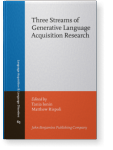Three streams of generative language acquisition research
Introduction
Tania Ionin | University of Illinois at Urbana-Champaign
References (16)
References
Chomsky, N. (1959). A review of B.F. Skinner's 'Verbal Behavior'. Language, 35, 26–58. 

Connor, M., Fisher, C., & Roth, D. (2013). Starting from scratch in semantic role labeling: Early indirect supervision. In A. Villavicencio, T. Poibeau, A. Korhonen, & A. Alishahi (Eds.), Cognitive aspects of computational language acquisition: Theory and applications of natural language processing. Berlin: Springer. 

Crain, S. (1991). Language acquisition in the absence of experience. Behavioral and Brain Sciences, 14, 597–650. 

Crain, S., & Thornton, R. (2008). Language acquisition. Essay for cognitive science in the classroom. Retrieved from <[URL]>.

de Villiers, J. G., & Roeper, T. (Eds.). (2011). Handbook of generative approaches to language acquisition. Dordrecht: Springer. 

Hadley, P., Rispoli, M., Fitzgerald, C., & Bahnsen, A. (2011). Predictors of morphosyntactic growth in typically developing toddlers: Contributions of parent input and child sex. Journal of Speech, Language and Hearing Research, 54, 549–566. 

Legate, J., & Yang, C. (2007). Morphosyntactic learning and the development of tense. Language Acquisition, 14(3), 315–344. 

Miller, K. (2012). Not all children agree: Acquisition of agreement when the input is variable. Language Learning and Development, 8, 255–277. 

Saffran, J. R. (2003). Statistical language learning: Mechanisms and constraints. Current Directions in Psychological Science, 12(4), 110–114. doi: 

Schwartz, B. D., & Sprouse, R. A. (2000). When syntactic theories evolve: Consequences for L2 acquisition research. In J. Archibald (Ed.), Second language acquisition and linguistic theory (pp. 156–186). Oxford: Blackwell.
Schwartz, B. D., & Sprouse, R. A. (2013). Generative approaches and the poverty of the stimulus. In J. Herschensohn & M. Young-Scholten (Eds.), The Cambridge handbook of second language acquisition (pp.137–158). Cambridge: CUP. 

Slabakova, R. (2016). Second language acquisition. Oxford: OUP.
Thompson, S., & Newport, E. (2007). Statistical learning of syntax: The role of transitional probability. Language Learning and Development, 3, 1–42. 

White, L. (2003). Second language acquisition and Universal Grammar. Cambridge: CUP. 

Yang, C. (2002). Knowledge and learning in natural language. Oxford: OUP.
